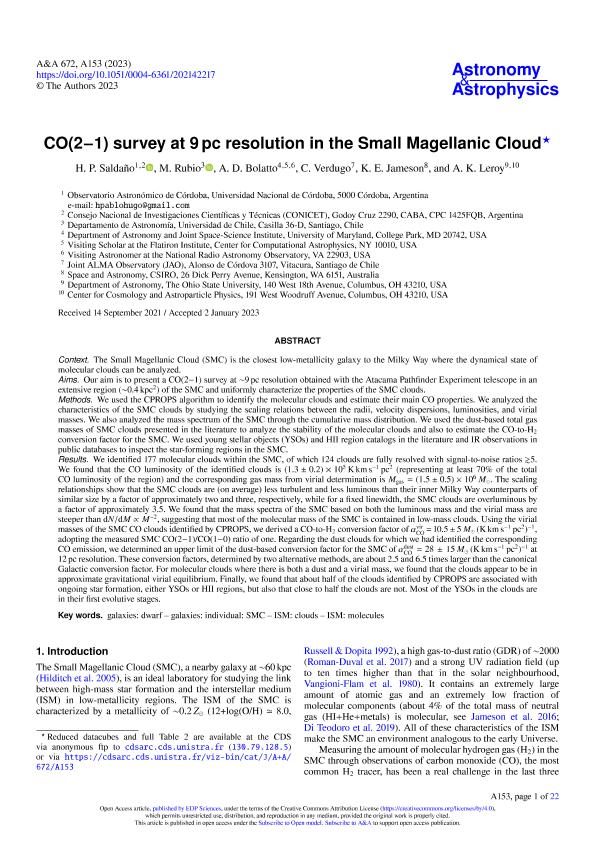Artículo
CO(2-1) survey at 9 pc resolution in the Small Magellanic Cloud
Fecha de publicación:
04/2023
Editorial:
EDP Sciences
Revista:
Astronomy and Astrophysics
ISSN:
0004-6361
e-ISSN:
1432-0746
Idioma:
Inglés
Tipo de recurso:
Artículo publicado
Clasificación temática:
Resumen
Context. The Small Magellanic Cloud (SMC) is the closest low-metallicity galaxy to the Milky Way where the dynamical state of molecular clouds can be analyzed. Aims. Our aim is to present a CO(2-1) survey at ~9 pc resolution obtained with the Atacama Pathfinder Experiment telescope in an extensive region (~0.4kpc2) of the SMC and uniformly characterize the properties of the SMC clouds. Methods. We used the CPROPS algorithm to identify the molecular clouds and estimate their main CO properties. We analyzed the characteristics of the SMC clouds by studying the scaling relations between the radii, velocity dispersions, luminosities, and virial masses. We also analyzed the mass spectrum of the SMC through the cumulative mass distribution. We used the dust-based total gas masses of SMC clouds presented in the literature to analyze the stability of the molecular clouds and also to estimate the CO-to-H2 conversion factor for the SMC. We used young stellar objects (YSOs) and HII region catalogs in the literature and IR observations in public databases to inspect the star-forming regions in the SMC. Results. We identified 177 molecular clouds within the SMC, of which 124 clouds are fully resolved with signal-to-noise ratios ≲5. We found that the CO luminosity of the identified clouds is (1.3 ± 0.2) ×105 K kms-1 pc2 (representing at least 70% of the total CO luminosity of the region) and the corresponding gas mass from virial determination is Mgas = (1.5 ± 0.5) ×106 M⊙. The scaling relationships show that the SMC clouds are (on average) less turbulent and less luminous than their inner Milky Way counterparts of similar size by a factor of approximately two and three, respectively, while for a fixed linewidth, the SMC clouds are overluminous by a factor of approximately 3.5. We found that the mass spectra of the SMC based on both the luminous mass and the virial mass are steeper than dN/dM αM-2, suggesting that most of the molecular mass of the SMC is contained in low-mass clouds. Using the virial masses of the SMC CO clouds identified by CPROPS, we derived a CO-to-H2 conversion factor of αCOvir = 10.5 ± 5 M⊙ (K km s-1 pc2)-1, adopting the measured SMC CO(2-1)/CO(1-0) ratio of one. Regarding the dust clouds for which we had identified the corresponding CO emission, we determined an upper limit of the dust-based conversion factor for the SMC of αCOdust = 28 ± 15 M⊙ (Kkm s-1 pc2)-1 at 12 pc resolution. These conversion factors, determined by two alternative methods, are about 2.5 and 6.5 times larger than the canonical Galactic conversion factor. For molecular clouds where there is both a dust and a virial mass, we found that the clouds appear to be in approximate gravitational virial equilibrium. Finally, we found that about half of the clouds identified by CPROPS are associated with ongoing star formation, either YSOs or HII regions, but also that close to half the clouds are not. Most of the YSOs in the clouds are in their first evolutive stages.
Palabras clave:
GALAXIES: DWARF
,
GALAXIES: INDIVIDUAL: SMC
,
ISM: CLOUDS
,
ISM: MOLECULES
Archivos asociados
Licencia
Identificadores
Colecciones
Articulos(INENCO)
Articulos de INST.DE INVEST.EN ENERGIA NO CONVENCIONAL
Articulos de INST.DE INVEST.EN ENERGIA NO CONVENCIONAL
Citación
Saldaño, Hugo Pablo; Rubio, M.; Bolatto, A. D.; Verdugo, C.; Jameson, K. E.; et al.; CO(2-1) survey at 9 pc resolution in the Small Magellanic Cloud; EDP Sciences; Astronomy and Astrophysics; 672; 4-2023; 1-22
Compartir
Altmétricas




